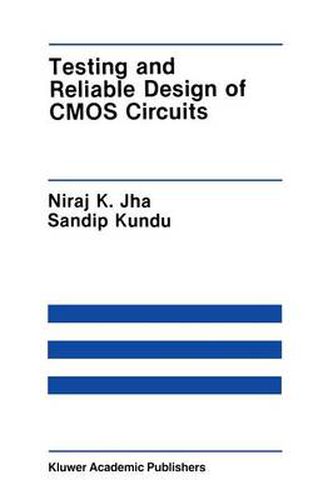Readings Newsletter
Become a Readings Member to make your shopping experience even easier.
Sign in or sign up for free!
You’re not far away from qualifying for FREE standard shipping within Australia
You’ve qualified for FREE standard shipping within Australia
The cart is loading…






This title is printed to order. This book may have been self-published. If so, we cannot guarantee the quality of the content. In the main most books will have gone through the editing process however some may not. We therefore suggest that you be aware of this before ordering this book. If in doubt check either the author or publisher’s details as we are unable to accept any returns unless they are faulty. Please contact us if you have any questions.
In the last few years CMOS technology has become increas ingly dominant for realizing Very Large Scale Integrated (VLSI) circuits. The popularity of this technology is due to its high den sity and low power requirement. The ability to realize very com plex circuits on a single chip has brought about a revolution in the world of electronics and computers. However, the rapid advance ments in this area pose many new problems in the area of testing. Testing has become a very time-consuming process. In order to ease the burden of testing, many schemes for designing the circuit for improved testability have been presented. These design for testability techniques have begun to catch the attention of chip manufacturers. The trend is towards placing increased emphasis on these techniques. Another byproduct of the increase in the complexity of chips is their higher susceptibility to faults. In order to take care of this problem, we need to build fault-tolerant systems. The area of fault-tolerant computing has steadily gained in importance. Today many universities offer courses in the areas of digital system testing and fault-tolerant computing. Due to the impor tance of CMOS technology, a significant portion of these courses may be devoted to CMOS testing. This book has been written as a reference text for such courses offered at the senior or graduate level. Familiarity with logic design and switching theory is assumed. The book should also prove to be useful to professionals working in the semiconductor industry.
$9.00 standard shipping within Australia
FREE standard shipping within Australia for orders over $100.00
Express & International shipping calculated at checkout
This title is printed to order. This book may have been self-published. If so, we cannot guarantee the quality of the content. In the main most books will have gone through the editing process however some may not. We therefore suggest that you be aware of this before ordering this book. If in doubt check either the author or publisher’s details as we are unable to accept any returns unless they are faulty. Please contact us if you have any questions.
In the last few years CMOS technology has become increas ingly dominant for realizing Very Large Scale Integrated (VLSI) circuits. The popularity of this technology is due to its high den sity and low power requirement. The ability to realize very com plex circuits on a single chip has brought about a revolution in the world of electronics and computers. However, the rapid advance ments in this area pose many new problems in the area of testing. Testing has become a very time-consuming process. In order to ease the burden of testing, many schemes for designing the circuit for improved testability have been presented. These design for testability techniques have begun to catch the attention of chip manufacturers. The trend is towards placing increased emphasis on these techniques. Another byproduct of the increase in the complexity of chips is their higher susceptibility to faults. In order to take care of this problem, we need to build fault-tolerant systems. The area of fault-tolerant computing has steadily gained in importance. Today many universities offer courses in the areas of digital system testing and fault-tolerant computing. Due to the impor tance of CMOS technology, a significant portion of these courses may be devoted to CMOS testing. This book has been written as a reference text for such courses offered at the senior or graduate level. Familiarity with logic design and switching theory is assumed. The book should also prove to be useful to professionals working in the semiconductor industry.